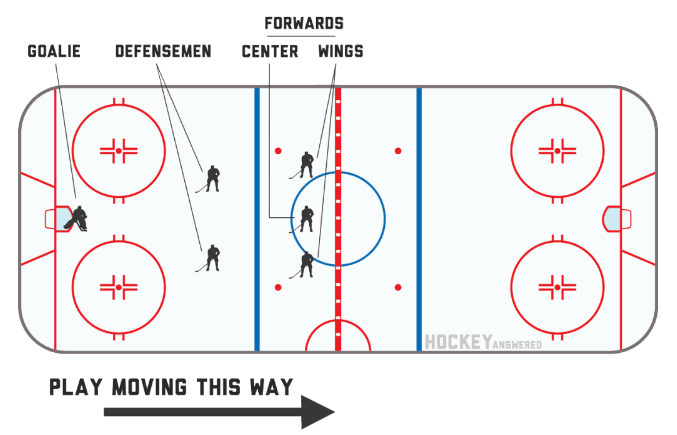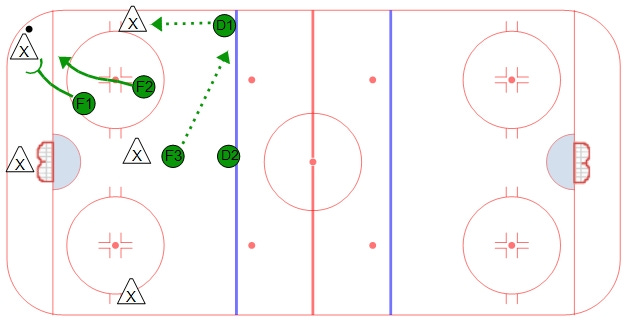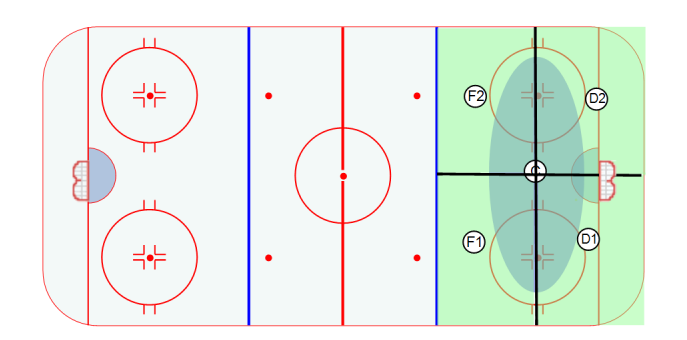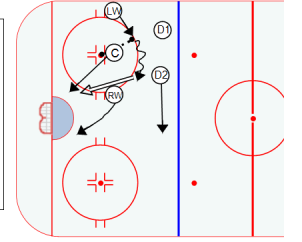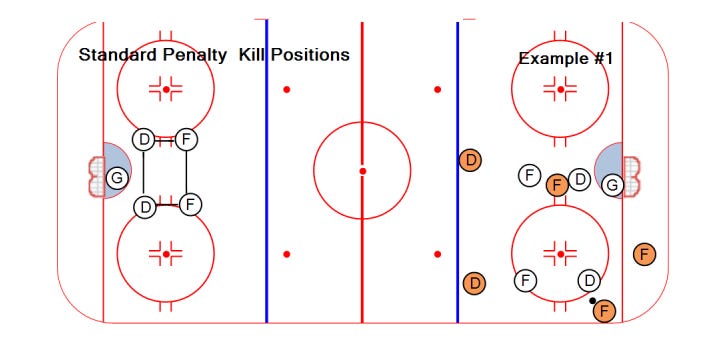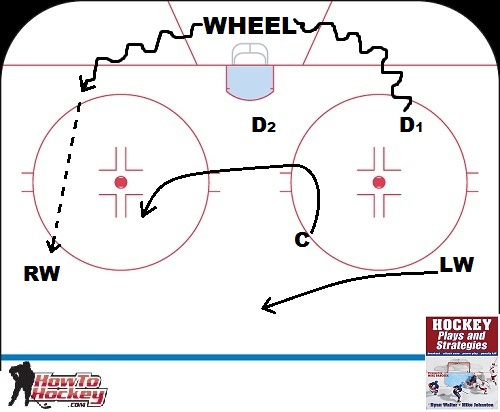Basic Youth Hockey Playbook you can Print off and Share with your team or Program
Ideal for U12 and younger
Ice Hockey Playbook
Hockey Rink and the Lines
Zones – Defensive zone, Neutral zone, Offensive zone
On a rink there are a total of 5 lines that go from one side of the boards to the next and 9 big dots spaced across the ice. The 5 lines help determine when a play should be stopped and the 9 big dots are used to help the play start again.
Let’s look at those lines first
Blue Lines: Offside The blue line basically acts a big guard against the offensive team. Its purpose is to give assistance to the defensive side by not allowing the other team to freely roam anywhere on the ice. The blue line does this by forcing the team to carry or shot the puck over the blue line before any player on their team is allowed in the zone from the blue line to the end of the boards.
If an attacking player crosses the blue line of his attack zone before the puck does then an official will blow the whistle and the game will come to a stop. The key here is that a player is allowed to have some of their body (head, body, one skate) cross the blue line before the puck as long as the trailing skate is on or above the blue line they are still considered onside. Want a deeper look at offsides?
Red Line: Icing
Hockey does not want teams to simply shoot the puck all the way down the ice as a defensive tactic to relieve pressure from an offensive attack. This would wreck the flow of the game and decrease scoring opportunities. Therefore, they instituted a few red lines to stop teams from shooting the puck all the way down the ice, which they refer to as ‘icing’.
Before simply shooting the puck into the other teams zone, a team must first pass the big red line in the center of the ice. If they do not pass this big red line and the puck goes down past the thin red line (called the goal line) in the other teams zone an official will blow the whistle to stop play.
To resume play a faceoff is then taken in the zone of the team who iced the puck. This is a disadvantage because it keeps the puck close to your goaltender, and many scoring chances and goals are developed off faceoffs in the opposing teams zone.
Penalties
Types of Penalties
Minor penalty – these are 2 minute penalties and are most commonly called for tripping, slashing, high-sticking, holding, interference, and delay of game
Major penalty – these are 5 minute penalties that can be the same type as a 2 minute minor penalty but the referee in his judgement has deemed the penalty to be one of an extra egregious play. Fighting by a player is deemed a major penalty
Match Penalty – this is a 5 minute penalty that also results in a player being removed for the duration of the game for intentionally injuring or attempting to injure another player
Misconduct Penalty – this is a 10 minute penalty but does not require that the team will be shorthanded while it is being served
Penalty Shot – there are a few scenarios where a penalty shot is awarded but the most common is when a player is interfered from behind when he is on a breakaway. The player then gets to take the puck from center ice in on the goalie for a free shot with no other players on the ice – very exciting!
Power play – the power play is the name given to the team that has gained an advantage by having more players on the ice when the other team takes a penalty. The team with the power play will either have a 5 vs 4, 5 vs 3 or 4 vs 3 advantage.
Penalty kill – this is the same scenario as a power play but from the view of the team that has taken the penalty. When a penalty is taken the team will be on the penalty kill. A team can take more than one penalty at a time but will never have less than 3 players on the ice.
Forecheck
The forecheck is an ice hockey defensive coverage play made (primarily) in the offensive zone with the objective of applying pressure to the opposing team to regain control of the puck.[1] It is a type of checking. Forechecking is generally executed in one of three situations: recovery of the puck after a dump in, after the rebound following a scoring attempt, or immediately after a turnover to regain possession.[2] Forechecking can be aggressive or conservative depending on the coaching style [3] and on the skating skills of the players.
Backcheck
The backcheck is an ice hockey defensive transition play made (primarily) in the neutral zone to the defensive zone. The purpose of the backcheck is to try to limit the opponents options as they head up the ice towards the backchecking team's end zone. [1] The backcheck may be initialized by situations such as having lost the puck in the opponent's half of the ice, the opponents having played through the first line of pressure in their own end zone, or having lost a faceoff in the neutral zone.
Defensive Zone Coverage
* Defenseman communicate and stay on your side
* Find and identify the guy your defending- and win your battles
* Sticks on the ice ALL the time in the D- Zone and keep your head on a swivel (be aware)
Offensive Zone Faceoff - Basic Alignment
* Wingers line up on hash marks/ D’s stay high/ Centers try to win to the board side wing or to the defenseman
Basic 5 v4 Penalty Kill In- Zone
Basic Hockey Breakouts
D to D- Defenseman use each other to breakdown the forecheck and keep the puck
Wheel- Defenseman evades the forecheck, keeps the puck and takes ice
Quick Up- Strong side D passes to strong side W quickly
Reverse- D partners use each other, and switch sides with the puck by using the boards to evade a hard forecheck
Stretch- Strong side Forward hangs far blueline and D takes advantage of a bad change or forecheck to go quickly from defense to offense
Here are examples…





